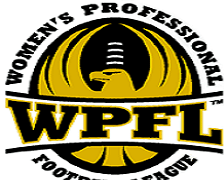Women playing (American) Football have it hard. The game itself is gruelling and physical, but the off-pitch attacks on their fitness for the game aren’t always centered on their physical condition. Sexism, so gallingly obvious in the Lingerie Football League, is ingrained. But beyond that, building female-specific training and rehabilitation methods, as well as proper equipment, appears to be as big a challenge as the sport itself.
Women playing full-contact tackle football face challenges beyond the playing field—yet there’s little research about this niche in athletics. Jennifer Carter, a University of Cincinnati doctoral student in the UC Department of Sociology, will present her research on body maintenance in women’s professional football at the 107th Annual Meeting of the American Sociological Association.
Carter first began her research observing a team in the Women’s Football Alliance (WFA), but she then became a defensive back, and learned firsthand how women condition themselves for such a physically demanding sport.
“My own participation in tackle football and observation shows that women players manage their bodies both on and off the playing field through equipment selection, the management of pain and injuries, and, finally, through conditioning and strength training,” says Carter.
Carter says women in professional tackle football are not only challenged by size options on their gear, but also by a lack of education when it comes to the proper fit and use of equipment, as well as the time of year when the women’s football season is played.
Equipment Challenges: “Everything from helmets and shoulder pads to shoes and pants—primarily designed for male football players—pose issues for women when it comes to finding the right fit,” explains Carter, who adds that gear that doesn’t fit properly won’t properly protect players.
Playing Season: Carter explains that the two largest women’s professional tackle football leagues, the WFA and the Independent Women’s Football League (IWFL), play football during the spring season, which is considered by sporting goods stores as the offseason for football. Female football players, in turn, are affected by a lack of available equipment at their local stores, as merchants stock up on traditional spring sporting gear for baseball and track, for example.
Conditioning and Strength Training: Carter says weightlifting, cardio-conditioning, and participating in football-related drills are a necessary part of organized football for both women and men. For the female players in her study, however, Carter found that much of their offseason conditioning was completed without coach or trainer supervision. She found that while the players had access to prime training equipment, they had little knowledge or guidance on how to properly use the equipment, therefore, increasing their risk of injury and decreasing effectiveness of workouts. She also found that the women’s knowledge of football-specific conditioning and strength-training was more limited.
“More specific to football, the lack of readily available opportunities for women to play at young ages, especially during high school years, contributes to a lack of knowledge of core training tenants, which young boys and men have often been exposed to over extended periods of time,” Carter says.
Carter also states that societal beliefs about women’s bodies affect the way they deal with pain and injuries. “While visible injuries on the field are dealt with similarly through a culture of sacrifice, off the field, women often face stigma due to visible bruising, cuts, scrapes, and other abrasions,” she says.
Carter conducted her research during the 2011 season and during offseason conditioning for the 2012 season as part of her larger dissertation research which is still underway. Carter says the players she studied came from diverse backgrounds and held jobs ranging from engineers, school administrators, and nurses to factory workers and cooks. Ages on the team ranged from 18 to 33.
She adds that although this was a professional football league, most of the players did not get paid. The WFA players who were paid generally earned $1 per game. Despite receiving low or no compensation, the athletes paid for their uniforms, equipment, field rentals, and travel expenses.
Carter says that as the sport continues to attract growing numbers of women, gaining an understanding of offering women more equitable opportunities on how to manage their bodies will become increasingly more important, not only in building talented players but in protecting them from injuries.
Source: American Sociological Association

The aim of art is to represent not the outward appearance of things, but their inward significance. – Aristotle




















